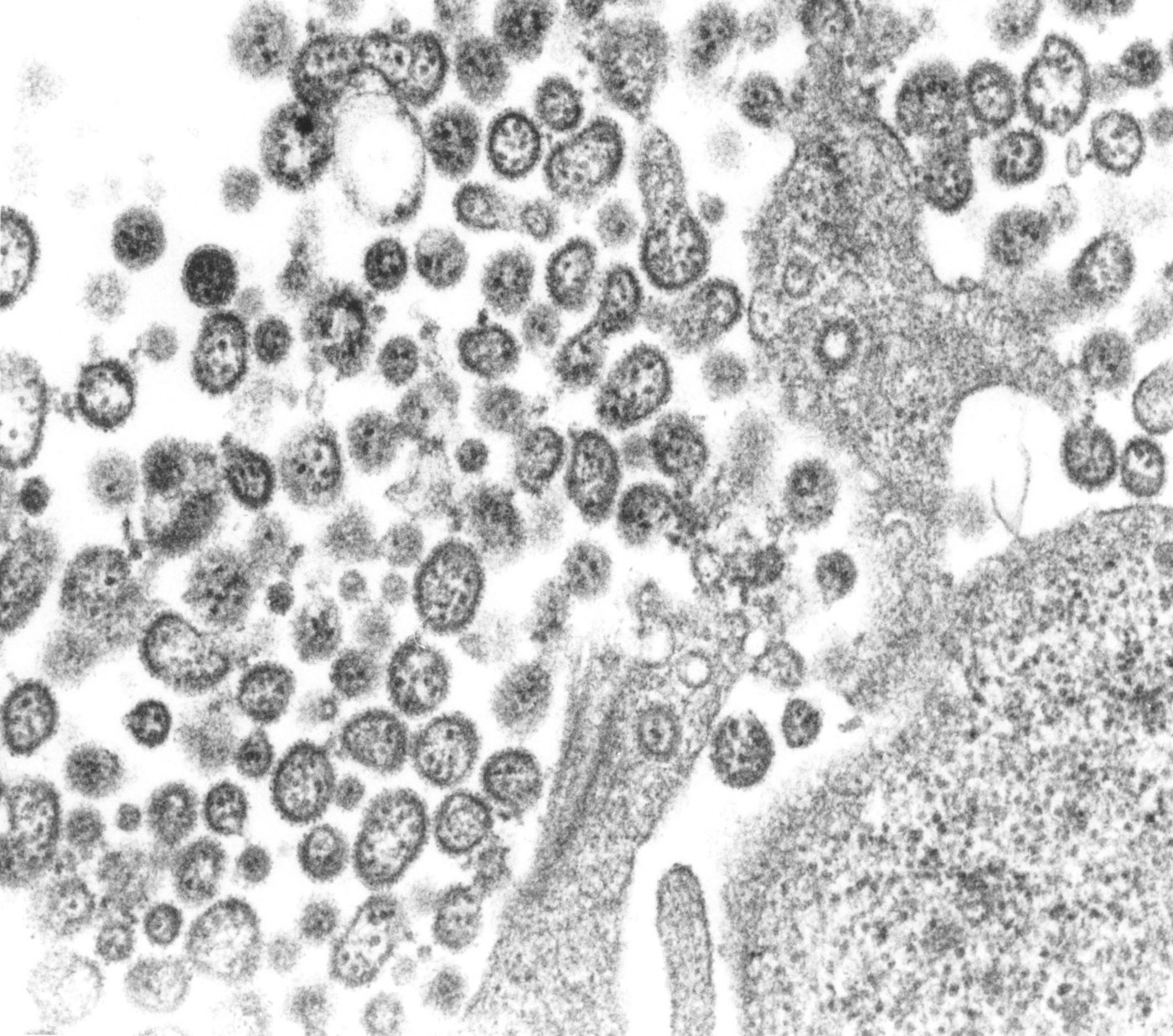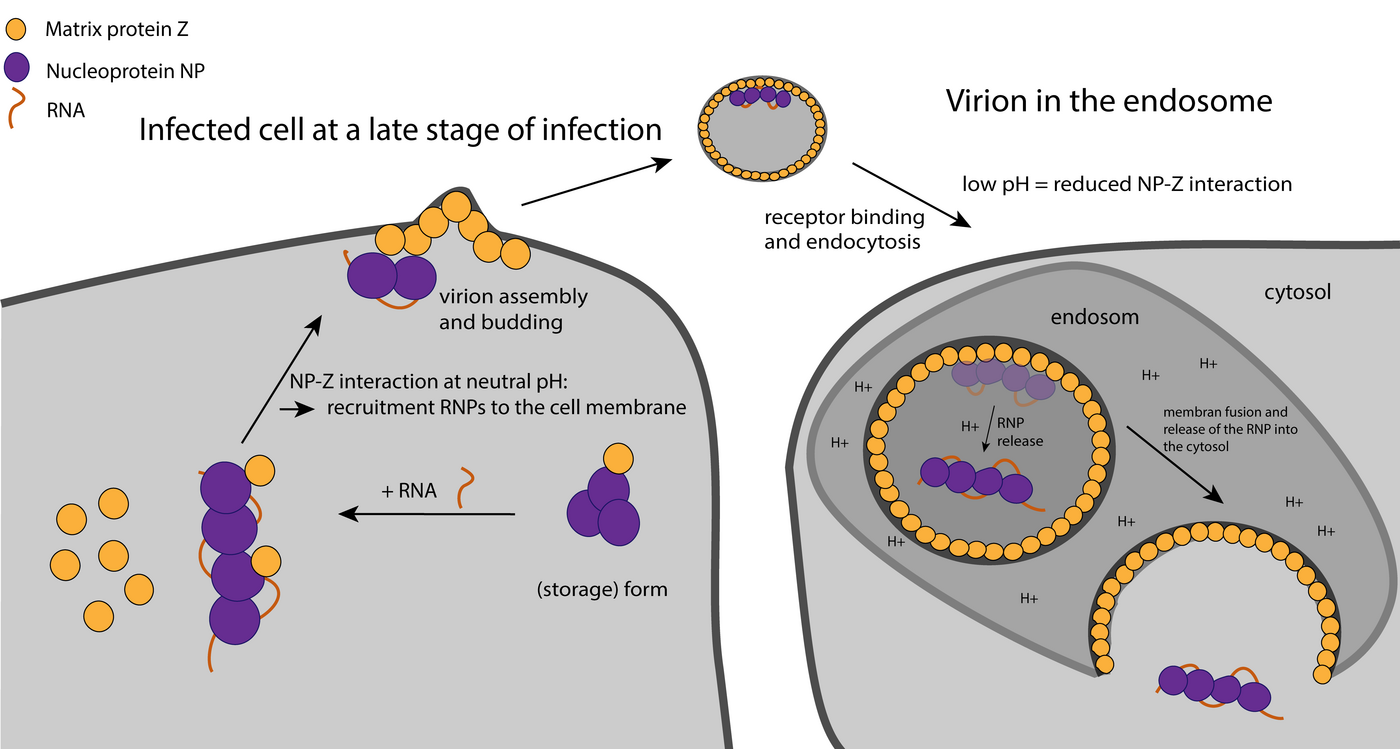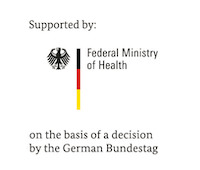Viral RNA triggers critical steps in Lassa virus life cycle
Researchers analyse viral molecules using native mass spectrometry
Understanding viral processes in human host cells is key to developing new antiviral drugs against the Lassa virus. Scientists from several institutions, including the Bernhard Nocht Institute for Tropical Medicine (BNITM) and the Centre for Structural Systems Biology (CSSB), used native mass spectrometry to study the interactions of viral molecules. One important result: RNA triggers the disassembly of a trimer - a set of three protein molecules - into individual protein molecules. This process is essential for the protection and replication of the viral genome. The results were published in the Journal of the American Chemical Society.
![[Translate to English:] Grafik Trimerstruktur des Nucleoproteins [Translate to English:] Grafik der ringförmigen Trimerstruktur des Nukleoproteins, dargestellt im Komplex mit dem Z-Protein. Daneben eine Grafik eines nativen Massenspektrums mit den Molekülen Z-Protein, NP-Trimer und NP-Trimer im Komplex mit dem Z-Protein](/fileadmin/_processed_/2/8/csm_Nucleoprotein_Trimer_5df0dac6e3.jpg)
Left: Structural prediction of the ring-like trimer structure of the nucleoprotein (yellow), shown in complex with the Z protein (turquoise). RNA triggers the disassembly of the trimer. Right: Native mass spectrum of the molecules Z protein, NP trimer and NP trimer in complex with Z protein.
Lassa virus (LASV) belongs to the arena virus family and is an RNA virus, which means that unlike DNA viruses, it stores its genetic information in the form of RNA. The Lassa virus is found in West African countries and can cause haemorrhagic Lassa fever. Between 100,000 and 300,000 people are infected with LASV each year, and about 5,000 of them die. To cause disease, the virus must replicate efficiently in the infected person's cells. The main steps in the Lassa virus life cycle are entry into the human host cell, replication of the viral RNA, packaging of the new viral RNA with the virus' own proteins and exit from the host cell.
Viral RNA triggers nucleoprotein trimer disassembly
In this study, the researchers led by Dr. Maria Rosenthal, group leader of the BMBF junior research group Structural Virology, focused on the so-called nucleoprotein (NP) of the Lassa virus. The nucleoprotein encapsidates the viral genetic information and thus protects the viral RNA from degradation in the human host cell. Nucleoproteins are initially present as stable, ring-like trimers - solid assemblies of three nucleoprotein molecules. Because of their ring structure, the trimers are unable to bind RNA. It was not known how this trimer structure is disassembled.
"We were able to show that the viral RNA itself triggers the breakdown of the trimer into individual protein monomers, which can then be recruited to the newly produced viral RNA," says the research group leader.
For their experiments, the research team used native mass spectrometry at the CSSB under the direction of Prof. Dr. Charlotte Uetrecht. This method works like an extremely fine balance, allowing the researchers to measure the smallest molecules in their natural (=native) form. "Since the proteins and also the protein complexes retain their native form, we can measure exactly how many RNA molecules are bound to a protein or whether protein monomers, dimers or trimers are present," explains Lennart Sänger, first author of the publication.
Nucleoprotein as a potential target for future antiviral drugs
For complete viruses to leave the host cell, the nucleoproteins must be transported to the cell membrane with the viral RNA bound to them and thus protected. This is done by the viral Z protein. Interfering with this transport process could be a possible strategy for the development of an antiviral drug. The interaction between nucleoprotein, RNA and Z protein has not been understood in detail. The BNITM researchers and their collaborators have now shown that the nucleoprotein and the Z protein bind directly to each other.
"A specific site in the nucleoprotein is important for this binding. In the future, this site could be used as a target for antiviral drugs," explains Sänger.

pH important for viral entry into host cell
RNA did not affect the binding between the Z and the nucleoprotein, but the scientists were able to show that the binding was pH dependent: the more acidic the environment (= low pH), the less the nucleoprotein and the Z protein interacted with each other. The results help to understand the viral entry into the host cell. After the Lassa virus has entered the host cell, it is located in the endosome, a cell compartment with an acidic environment. The researchers were able to show that the low pH of the endosome is important for the release of nucleoproteins with bound viral RNA from the viral envelope, which consists of Z proteins.

"Using a structural biology method, native mass spectrometry, we were able to further elucidate important steps in the life cycle of the Lassa virus. A better understanding of the interactions of viral molecules can help us to develop antiviral drugs," concludes structural biologist Rosenthal.
Original publication
Sänger L. et al. „RNA to Rule Them All: Critical Steps in Lassa Virus Ribonucleoparticle Assembly and Recruitment.” J. Am. Chem. Soc. (2023)
Cooperation partner institutions
Centre for Structural Systems Biology (CSSB)
Leibniz Institute of Virology (LIV)
European Molecular Biology Laboratory (EMBL) Hamburg
Fraunhofer Institute for Translational Medicine and Pharmacology (ITMP)
Faculty V, School of Life Sciences, University of Siegen
Deutsches Elektronen-Synchrotron (DESY)
Funding
Leibniz Center Infection Graduate School and Leibniz Interact
The Leibniz Institute of Virology was supported by the Free and Hanseatic City of Hamburg and the Federal Ministry of Health
German Federal Ministry of Education and Research
German Research Foundation (DFG)
Leibniz Association’s Leibniz competition programme and grant
Horizon 2020 ERC
BWFBG of the Free and Hanseatic City of Hamburg for an equipment grant
Wilhelm und Maria Kirmser-Stiftung
Contact person
Dr Maria Rosenthal
Research Group Leader
Phone : +49 40 285380-930
Email : rosenthal@bnitm.de
Lennart Sänger
Phone : +49 40 285380-930
Email : lennart.saenger@bnitm.de
Dr Anna Hein
Public Relations
Phone : +49 40 285380-269
Email : presse@bnitm.de
Further information







